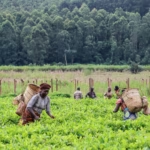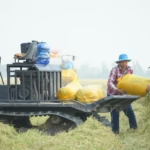
Africa’s agricultural backbone is built on the hard work of its farmers, many of whom operate in rural regions, cultivating the land with care and dedication. But in today’s connected global economy, farming is no longer just about growing crops—it’s about being part of a wider ecosystem that stretches from the soil to the shelves of international markets. For those farmers working with companies like Ahar, their roles are increasingly integrated into what we now understand as the African farmer supply chain.
This blog takes a closer look at a typical day in the life of one such farmer—Abdoulaye, a cashew farmer in Côte d’Ivoire—and how his work fits into a larger chain of events that ensures high-quality produce reaches buyers around the globe.
Morning: Groundwork Begins at Dawn
Abdoulaye’s day begins before the sun fully rises. Like many farmers across Africa, he relies on the early hours to check the condition of his trees and prepare for harvesting. The calm of the morning allows him to plan his activities, assess soil moisture, and inspect for signs of pests or diseases.
This stage may seem simple, but it is crucial. The African farmer supply chain starts right here—in the soil. Every healthy nut or grain harvested begins with a well-tended field. Thanks to guidance and training from Ahar’s local agricultural officers, Abdoulaye uses better irrigation methods and organic fertilization practices that not only increase yield but improve sustainability.
Late Morning: Harvesting with Care and Precision
By mid-morning, the harvesting begins. Whether it’s cashews, sesame, or maize, careful picking ensures minimal damage and helps maintain quality. Abdoulaye and his team of seasonal workers use baskets and sacks to collect mature produce, ensuring only the best-quality items make it past this initial stage.
Ahar has introduced simple yet effective quality-control techniques at the farm level—such as separating cracked or damaged nuts immediately. This ensures consistency and reduces post-harvest loss, a major challenge in many agricultural communities.
This step is an essential link in the African farmer supply chain. What happens during harvest has a direct impact on the quality and market value of the final product.
Afternoon: Sorting, Drying, and Quality Checks
Once the harvesting wraps up, the produce moves on to sorting and drying. In Abdoulaye’s case, freshly picked cashew nuts are laid out on large mats in the sun. Here, moisture is reduced to prevent mold and deterioration.
This stage requires patience and attention. Ahar Group works closely with its network of farmers to offer training on ideal drying times, handling practices, and hygiene standards—ensuring the produce is export-ready. Abdoulaye often attends local workshops hosted by Ahar’s outreach team, learning how proper handling can increase his profit margins.
It’s in moments like these that the impact of being part of a structured African farmer supply chain becomes evident. The guidance, access to equipment, and connection to larger markets provide a clear advantage compared to working in isolation.
Evening: Preparing for Pickup and Traceability
As the day winds down, the produce is carefully packaged and stored in sacks tagged for traceability. One of Ahar’s core commitments is transparency in sourcing. This includes a robust traceability system where every batch of goods can be traced back to its origin farm.
Each package carries information such as the farmer’s name, location, harvest date, and batch number. This level of transparency has made Ahar a trusted name among international buyers, who increasingly demand accountability in their supply chains.
Being part of a transparent African farmer supply chain gives farmers like Abdoulaye more than just recognition—it builds long-term trust and often translates to better prices and repeat business.
Logistics: Moving from Farm to Global Market
Soon after packaging, Ahar’s logistics team arrives for collection. The goods are taken to a local processing center, where they undergo further cleaning, grading, and in some cases, value addition. Once processed, they are prepared for export—complete with documentation that complies with international standards.
Ahar ensures that this step is as efficient as possible. By coordinating logistics directly with farming communities, the company reduces delays and waste, making the African farmer supply chain more responsive and profitable.
More Than Just a Transaction
For Abdoulaye, working with Ahar is not a one-time deal—it’s a relationship. The partnership offers access to improved farming techniques, guaranteed offtake of his produce, and a fair price. In return, Ahar secures consistent, high-quality products for its global clients.
What makes this approach work is that it’s not built around exploitation but empowerment. Farmers are not left out of the value chain—they are central to it. Through partnerships like these, the African farmer supply chain is being reimagined from the ground up, focusing on sustainability, equity, and long-term growth.
The Bigger Picture
Ahar’s model offers a glimpse into what the future of African agriculture can look like—where local farmers are connected to international markets not just as raw suppliers, but as valued partners. With climate change, rising global demand for ethically sourced produce, and the increasing role of digital tools, companies that embrace such holistic approaches are leading the way.
Through digital training, traceability programs, fair contracts, and sustainable practices, Ahar is helping reshape the African farmer supply chain—creating a system that benefits both producers and consumers.
Conclusion
The story of Abdoulaye is not unique—but it’s one that is increasingly common across Africa thanks to companies like Ahar. From early-morning fieldwork to final packaging for global export, the journey of agricultural goods is long and filled with important checkpoints.
Every link in the African farmer supply chain matters. And when each one is respected, supported, and optimized, it results in better livelihoods for farmers, safer food for consumers, and a more balanced global food system.
In the end, the journey from harvest to export is more than just a supply route—it’s a testament to the power of collaboration, commitment, and shared growth.











Add comment